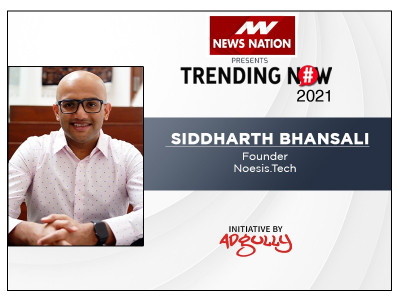Digital transformation cannot be treated as a knee-jerk reaction: Siddharth Bhansali
Shrugging off the disruptions of last year, businesses and agencies are looking for a strong revival in 2021. Adgully – as part of our annual TRENDING NOW endeavour – has been presenting the strategies and views of a cross-section of industry leaders as they go about reclaiming lost time and market opportunities and build for a stronger future, armed with the lessons of 2020.
In conversation with Adgully, Siddharth Bhansali, Founder, Noesis.Tech, speaks about how enterprises need to be ready for the digital future, focussing on first-party data for long-term solutions and much more.
Also read: “Constant deliberate innovation focus is a critical need for businesses today”
Outlook for 2021
Digital Transformation is a Necessity: Enterprises need to be ready for the digital future. The pandemic acted as an accelerator for digital adoption, which grew 5x. While most companies have over the past one year taken the steps to make their operations digitally ready, the pandemic has shown us that it is no longer an option. Digital transformation is a necessity to keep one’s business thriving.
Today, 90% companies are using cloud services for daily business operations. However, digital transformation goes much beyond merely migrating data. It includes the creation of a framework that transforms existing services and data into actionable insights. These can be leveraged to strengthen and revamp just about all aspects of an organisation’s business. Think of it as designing a well-oiled machine that is built to run smoothly. It would need one to put in constant effort and diligence. This will aid accelerated results in a seamless manner.
Digital transformation cannot be treated as a knee-jerk reaction. Before the pandemic hit, companies would focus on it for cost saving, revenue optimisation, incremental improvement in efficiency, etc. Today, it is the fulcrum on which businesses are able to chart their success path. It has proven to be instrumental in helping businesses reach optimal potential. Especially in the time of a crisis, a sound digital transformation strategy builds resilience. For companies to be 100% equipped for the future, they need to have a digital transformation roadmap ready.
First-Party Data to Rule: Brands have created various digital interfaces between them and their stakeholders to understand consumer behaviour, vendor satisfaction, payment cycles, etc. Consumer tastes and market dynamics are changing at an unprecedented pace. Companies can no longer afford to rely on an analyst’s trend reports for industry insights or depend on 3rd party tools to provide insights on some kind of sampling of the population. The consumer environment is changing. Developing unique first party data collecting tools for one’s business will help in understanding customer/ stakeholder trends in real time and define what businesses need to focus on. Companies who don’t have their own data and are only relying on market available data may end up playing catch-up to the industry.
Take the case of BMW, who introduced a revamped version of their ‘Build Your Own BMW’ feature in the middle of the pandemic. As customers started using this feature, BMW was presented with a wide range of first-party information. The collected data offered insights into improving manufacturing and supply chain operations (since they were under significant constraints due to the lockdown). This kind of data helped them allocate organisational resources and ensure that their production was perfectly in line with customer expectations and demands. While the starting point may be different for every company, one thing is certain. Improving first-party data capabilities can help companies adapt to changing situations. When used strategically, first-party data can help keep pace with changing consumer preferences and deliver better experiences.
The emergence of hybrid ecosystems: In the pre-Covid era, we had a binary way of communicating with our stakeholders. It was either completely digital like in the case of e-commerce companies or it involved interaction in the physical world. However, the pandemic has given rise to a new hybrid ecosystem. Consumers are now delighted when existing brands add an element of human interaction to their digital interfaces. The introduction of chatbots is an excellent example of this phenomenon so that consumers don’t lose the essence of the brand.
Companies can no longer rely only on physical connections to sustain and build relationships with consumers. Take the case of SuperHuman. It is an app that promises to provide consumers with the fastest email experience. It has over a million downloads today. Interestingly, before consumers are allowed to sign in and pay for the app, it conducts 15-min video calls with all potential customers. By doing so, it aims to understand specific needs and guide them to have a seamless experience with the app.
Moving forward, the key will be in being able to blend aspects of humanity in the businesses. It has to evolve to include tenets of both in equal measure to as to create long-lasting relationships with customers.
Great Expectations
Focus on First-party data for long-term solutions: Allow me to begin with an example. Policy Bazaar, India’s leading insurance aggregator, was one of the earliest companies to discover a goldmine of consumer insights. They scoured through their 35 million minutes of monthly talk time via voice analytics. One of the key insights they found was that a lot of customers were using the word ‘cashless’. The marketing team leveraged this insight in their next campaign. And they drove successful results.
Forward-thinking organisations have already prioritised addressing first-party data management to create market dominance. However, unlocking the potential of first-party data depends on how well a company can integrate its data sources and link them to marketing activities. Companies are releasing the significance of data in creating contextual engagement. This will open doors for a more profitable long term strategy.
Faster adoption of digital brokers: Not all organisations are poised to build their own technology or digital infrastructures. Take the case of small-time vendors who sell products on websites such as Amazon. The e-commerce website acts like a ‘digital broker’ for them who supports the technological shift. Embracing these platforms allows organizations to enter the digital transformation marathon. As companies rely on these digital brokers to aid their transformation, one can expect a surge in demand for interface providers. They are not only limited to the e-commerce industry. Soon, they will be industry agnostic.
E-learning on the fastrack: E-learning has an even stronger and powerful proposition than it did last year. Considering how experimental 2020 was in nature, we can expect dramatic changes. Elements like accommodation space and classroom space are no longer limiting factors. As companies become more comfortable with the characteristics of e-learning, it will open a whole new range of micro-learning opportunities. It will soon extend to aspects of corporate training, KRA development, upskilling, and the creation of a robust learning management system. In conjunction with Artificial Intelligence, assessment engines, and other tools, companies can leverage e-learning as a robust L&D tool as well.
Key learnings from 2020
Digital transformation will be at the core of increased productivity and efficiency. To yield profits and stay on the growth part, companies need to deploy a myriad of practices.
Various search engines announced that they would do away with third-party cookies. This meant that brands could no longer rely on them to create consumer cohorts. Focusing only on an external source for data could prove detrimental to business. In a cookie-less world, marketers will have to invest more time in building new customer data platforms.
Customers are looking forward to a hybrid experience. One that will consist of a mix of technology and human experience to influence purchase decisions. If the first connection has been through a digital medium, then maybe the service delivery may have a human essence. This would help build trust.
Personalised and interactive learning experiences to help employees will be the norm.
For more updates & collaboration, connect us on :
WhatsApp, Instagram, LinkedIn, Twitter, Facebook & Youtube

















Share
Facebook
YouTube
Tweet
Twitter
LinkedIn